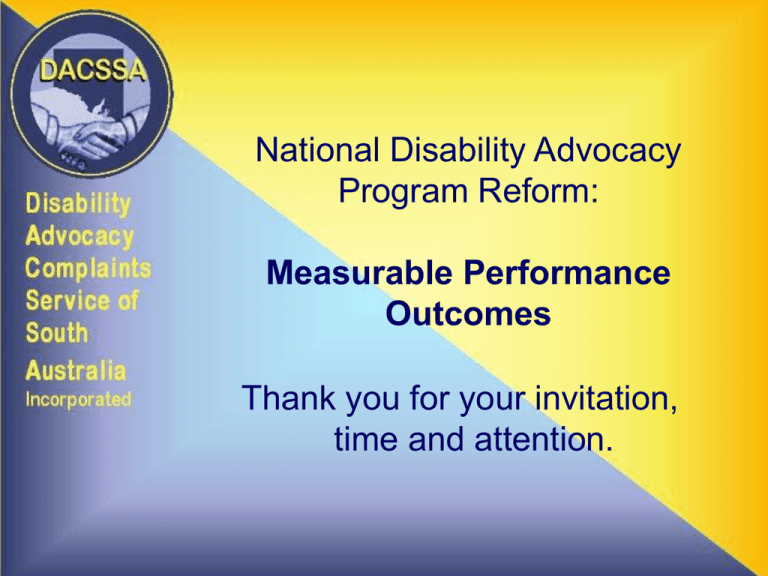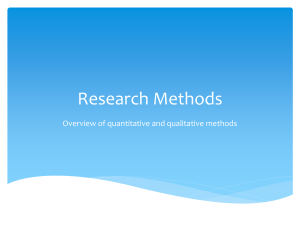Developing Measurable and Appropriate Outcomes
advertisement

National Disability Advocacy Program Reform: Measurable Performance Outcomes Thank you for your invitation, time and attention. What is measurable? • Numbers - Statistics • Relations between numbers • Client Satisfaction • Staff Satisfaction • Compliance with Standards Where comparison of data is important data to be collected has to be valid, comparable to the data other services collect and collected in a way that it can be verified. Client and Staff satisfaction levels are very subjective and dependent on a range of circumstances. Compliance with Standards is already a requirement, although the standards and performance indicators could be improved. What is Performance? Performance of service providers has to be measured on standards/performance indicators. NDAP already has a performance measurement system with audits required every five years. Performance should never be measured on statistical data only, but predominantly on compliance with standards. Compliance with standards must be documented in all areas. Performance could also be measured on statistical data. Compliance with performance indicators is part of an ongoing quality improvement system. What are Performance Outcomes? Performance outcomes, measured on statistics only, may be (ab)used to determine funding levels. Outcomes could be defined as the • % of clients from a CALD background; • Cost per client per year; • Ratio of advocates to issues resolved; • Number of clients to be assisted; etc. Mixing of Quantitative and Qualitative Data Example: Comparison of data about issues and length of time worked on an issue; Linking level of resolution to kind of, or level of, disability; Qualitative research, broadly defined, means "any kind of research that produces findings not arrived at by means of statistical procedures or other means of quantification" (Strauss and Corbin, 1990, p. 17) and instead, the kind of research that produces findings arrived from real-world settings where the "phenomenon of interest unfold naturally" (Patton, 2001, p. 39). Unlike quantitative researchers who seek causal determination, prediction, and generalization of findings, qualitative researchers seek instead illumination, understanding, and extrapolation to similar situations (Hoepfl, 1997). Reliability - Validity Examples: How do you identify CALD clients? How do you identify the category to place issues? If your funding would depend on boosting your numbers, would you? Joppe (2000) defines reliability as: …The extent to which results are consistent over time and an accurate representation of the total population under study is referred to as reliability and if the results of a study can be reproduced under a similar methodology, then the research instrument is considered to be reliable. (p. 1, Joppe, M. (2000). The Research Process. Retrieved February 25, 2000, from http://www.ryerson.ca/~mjoppe/rp.htm) Validity determines whether the research truly measures that which it was intended to measure or how truthful the research results are. In other words, does the research instrument allow you to hit "the bull’s eye" of your research object? Researchers generally determine validity by asking a series of questions, and will often look for the answers in the research of others. (p. 1) The Qualitative Report Volume 8 Number 4 December 2003 597-607 http://www.nova.edu/ssss/QR/QR8-4/golafshani.pdf Nahid Golafshani: Understanding Reliability and Validity in Qualitative Research,University of Toronto, Toronto, Ontario, Canada Critical Issues: What kind of data is collected and for what purpose? How (with what criteria) will the data be evaluated? How will advocacy services be involved in the development of performance standards and an ongoing quality improvement system, which can be reliably assessed? How will advocacy services be involved in the setting of performance outcomes or targets, which may determine the level of funding we receive, and how do we ensure that the outcomes assessed are reliable and valid? How will such targets be developed? Will there be consultation with people with disabilities and their support persons? If targets are set, what will be the consequences of not meeting such targets? Proposal FaCSIA should commission two studies: 1. Review of the existing audit system, based on the recent audit, and whether the existing standards and performance indicators are useful for all stakeholders and fulfill their intended purpose; 2. Undertake a survey of existing agencies and ask the following questions: 1. 2. 3. 3. What does your agency count as a program outcome and how do you measure it? How do you integrate the existing quality improvement system in the daily work of your agency? What would you change about the standards to make them more applicable to your situation? The results of both studies should be used to develop a meaningful performance measurement system. In Conclusion Clearly, in the United States there has been a growing emphasis on outcomes measurement, performance outcomes and results from the national to the local levels. However, perhaps it is now time to take stock of progress to date in the use of outcomes data. The question I would like to pose for consideration is to what extent have the results of outcomes measurement been used in your countries– do outcomes matter? If so, to whom do they matter? If not, what needs to be done to assure that they will matter? Toward outcomes measurement in the human services © Copyright 2001 Edward J Mullen Edward J Mullen Centre for the Study of Social Work Practice Columbia University DACSSA Inc. Funded by the Australian Government as part of the National Disability Advocacy Program. Thank You! Our contact details are: Unit 3, 178 Henley Beach Road (enter from Jervois Street) Torrensville SA 5031 Phone: Fax: Country: 8234 56 99 8234 60 44 1800 088 325 Email: drigney@dacssa.org.au Website: www.dacssa.org.au






